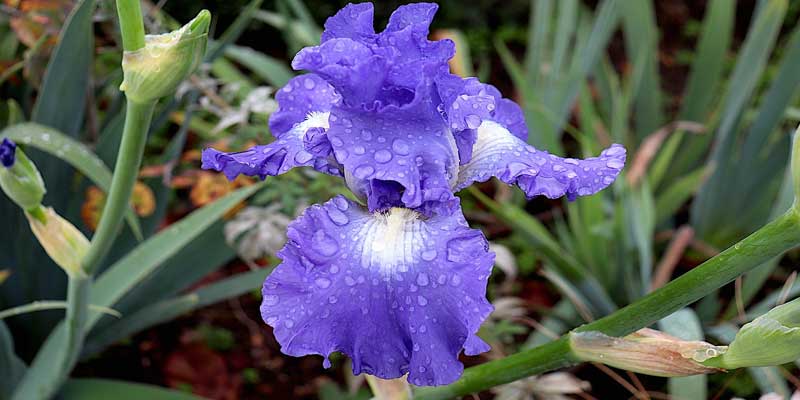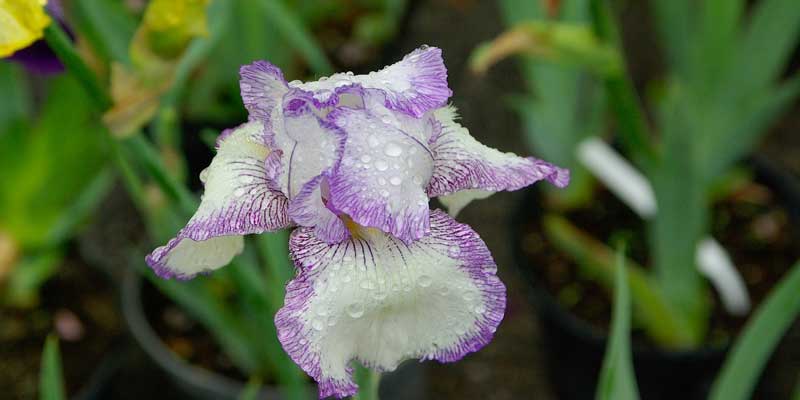Irises, with their lively blossoms and gentle appearance, bring a sense of sophistication to every garden scenery. If you have much experience in gardening or are new at it, understanding the proper way to take care of your irises specifically when watering is crucial for their good condition and vigor.
Although these sturdy plants can endure numerous circumstances, achieving the correct frequency of watering could affect significantly how they grow and produce flowers.
Understanding Iris Water Needs
Now, let’s talk about how often irises should be watered. But before we do that, it is very important to understand the needs of irises when it comes to water. Ireises are a kind of flower from the Iris genus. This group includes many species, and each one has its own preferences for how much moisture they like.
However, most irises – like bearded iris (Iris germanica) and Siberian iris (Iris sibirica) – usually prefer soil that drains well and holds moderate amounts of water.
How Often To Water Iris?
Irises usually love soil that is evenly damp but not soaked in water. Too much water can make their roots sick with rot and other kinds of fungal sicknesses, while too little water might stress them out and stop them from making good flowers. It’s important to manage the amount of watering they get.
4 Factors Influencing Watering Frequency
Several factors influence how often you should water your irises:
1. Climate
The watering requirements of irises differ based on the climate in your area. In hotter and drier environments, you might have to water them more often so that the soil doesn’t become fully dry. Conversely, in cooler and more humid climates, less frequent watering may be necessary.
2. Soil Type
The kind of soil you have in your garden affects how well it holds water. Sandy soils can drain fast which might need more often watering, whereas clay-like soils keep moisture for longer and may not require as much watering frequency. Amending the soil with organic matter can improve its ability to retain moisture.
3. Planting Location
Irises that are in containers or elevated beds might need watering more often compared to those planted straight into the soil. The irises that are grown in containers can dry up faster, particularly when it’s hot outside, so checking them regularly is very important.
4. Establishment Phase
At first, irises that have just been planted need more water as they are settling in and growing a robust root structure. After they’ve taken root, mature irises can withstand drier conditions without needing as much watering.
6 Tips For Watering Irises
There is not an exact method for watering irises that suits all situations. These hints can assist you in figuring out the best frequency to water your plants:
1. Observe Soil Moisture
Feel the soil around the plant’s base by putting your finger in it, before you water. If it seems dry when touched, that means watering is needed. Avoid watering if the soil is still moist.
2. Water deeply and less often
When it’s time to water, give a good amount each time to encourage deep growth of roots. If you only provide shallow watering, then your plant will have shallow roots which are more likely to experience stress from droughts. Deep watering is better for plants because it promotes a stronger root system.
3. Morning Watering
Give water in the morning because during this time, any extra humidity will disappear as the day progresses which lessens chances for fungus diseases to grow. Do not water at night since it can create a wet environment overnight that promotes fungal growth.
4. Use Mulch
Spread a layer of natural mulch, like compost or shredded bark, around the bottom part of your plants. This will keep soil wetness and stop weeds from growing. Mulching also helps to control temperature in soil by keeping roots cool during hot weather.
5. Change Watering Methods with Weather
In hot, dry times you might have to water more often so that the ground doesn’t become too dry. But when there’s a lot of rain or it’s cooler outside, you can decrease how frequently watering is needed.
6. Think about Microclimates
Every part of your garden can have different microclimates, which may affect how much moisture they hold. Use soil moisture meters in various spots and alter the watering routine when needed.
Signs of Overwatering and Underwatering
Knowing the signs of overwatering and underwatering can help you to adjust your watering habits appropriately.
Overwatering
- Yellowing or browning of leaves
- Wilting despite moist soil
- A foul odor emanating from the soil
- Mushy or rotting roots
Underwatering
- Wilted or drooping leaves
- Yellowing or browning of leaves, starting from the tips
- Dry, crumbly soil
- Stunted growth or lack of flowering
Conclusion
Watering irises is like an art, where you need to be observant and trust your feelings. You might have to try a few times before finding the right amount of water that works best for your irises. By knowing how much water they need and looking at the surroundings, you can make sure there’s a good mix of moisture with drainage – this will give them what they require for growing well and producing lively flowers.
Don’t forget about changing how often or how much water you give as time passes during their growth period; always keep an eye on them! If you take care of them well, your irises will give you their ageless charm continuously from one year to another.



Leave a Reply